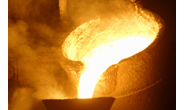International Steel Mills

China Challenges CR Duties, Considers Relocating Capacity
Written by Sandy Williams
May 22, 2016
Last week the Department Commerce slapped AD/CVD duties totaling over 500 percent on China cold rolled steel flat products. China immediately challenged the determination, calling for removal of the penalties and reaffirming the rebates awarded to its industry to help with solving the steel and coal overcapacity. The Chinese Ministry of Commerce confirmed that it will continue its preferential tax policies to help fund industrial restructuring as well as continuing steel export tax rebates.
“China is extremely dissatisfied with this decision,” China’s Ministry of Commerce said in a statement, adding the country “urges the US to strictly abide by World Trade Organization guidelines and correct its mistake as quickly as possible.”
“The United States adopted many unfair methods during the anti-dumping and anti-subsidy investigation into Chinese products, including the refusal to grant Chinese state-owned firms a differentiated tax rate,” said the Ministry.
China claims that it is not encouraging Chinese steel producers to dump their products on foreign market. China exports are, instead, natural trade flows determined by the marketplace.
China media Xinhau, quoted the Ministry as saying that U.S. anti-dumping and countervailing duty investigations into some carbon and alloy steel imports from 12 countries, including China, South Korea and Japan were “imprudent.”
A statement from the Ministry of Commerce said, “The United States has recently taken a series of trade remedy measures against steel exports from other countries and regions. Such acts are imprudent and cannot help U.S. steel businesses solve their problems. After more than three decades of protection and subsidies, the United States has distorted competition in its domestic steel market, deprived local companies of motivation to increase investment or improve technology and subsequently blunted their competitive edge.”
The Ministry said on its website, “At present, the global steel industry is facing difficult operation and overcapacity, resulting from weak economic growth and global demands. It’s a common problem that all countries need to cope with. Therefore, to simply and frequently adopt trade protectionism measures makes no contributions to the basic solution of the common and temporary problem which is challenging steel industries of all countries.”
China has announced capacity cuts of 100 to 150 million tonnes to trim its current annual production capacity of1.1 billion tonnes. The cuts were to come from closures of outdated and failing mills and tight restrictions on building of new facilities. Funding of USD 15.29 billion was earmarked by the central government to resettle and retrain displaced workers. An estimated 1.8 million coal and steel workers are expected to be laid off due to capacity cuts.
When the capacity cuts were announced, steel prices in China were at a low. A pricing rebound of 80 percent in the period from late November to April restarted a frenzy of production and fears that government mandated capacity cuts are in danger.
On Thursday, May 12, Reuters reported that Zhao Chenxin, a spokesman with the National Development and Reform Commission (NDRC) said rising prices would not hinder efforts to reduce overcapacity. The recent rapid improvement in Chinese steel prices is not sustainable, he said.
“Rising steel prices have some impact on cutting overcapacity, but in general the impact is very small,” Zhao Chenxin, a spokesman with the National Development and Reform Commission (NDRC), told a media briefing in Beijing.
After hitting their lowest point in decades last year, steel prices surged 80 percent from late November to their recent peak on April 21, but have since fallen back around 25 percent.
Zhao said optimism over steel demand has been driven by rising housing sales, a resumption in construction activities and restocking by traders. Lower production rates earlier this year and futures market speculation also helped lift prices, he said.
“The supply and demand situation hasn’t essentially improved, and the serious overcapacity hasn’t changed, so steel prices will be unlikely to maintain the rapid increase,” he said.
The higher prices have encouraged some shuttered steel mills in the world’s top producer to resume production, and leading steelmaker Baoshan Iron & Steel warned this could slow government efforts to curb overcapacity in the short term.
“The restarted capacity is not on the list of those (mills) that have been ordered to shut down, and the reopening is normal market behavior, mainly in reaction to market changes,” Zhao added.
Beijing would continue to urge local governments to push forward steel industry capacity cuts and take reasonable measures to accelerate closures, he said.
Said one of SMUs trading sources located in Asia:
“Have been silent last few months as market in total chaos and frankly speaking, no one having any idea when the waters would calm. Fortunately, we now know that a big correction is coming in June. We have seen prices plummet over the past few weeks, and then slightly rebound, but that was only due to domestic traders taking advantage of this round of decreases at the bottom. The next big adjustment will be in June, next month.”
Steel prices in China have fallen 25 percent from the April peak. The China Iron and Steel Association reported their composite index on spot prices down 7.4 percent to 76.45 as of Monday, May 16, but expansion plans are pushing on.
Average daily crude steel production increased to a record high in April, up from 2.279 million tonnes to 2.314 million tonnes.
“With no changes in the excess supply situation, the big increase in production by steel enterprises will worsen the gap between supply and demand,” warned CISA. “Steel enterprises should carefully analyse market changes and not blindly expand production.”
Despite warnings, so called “zombie plants” are coming back to life through acquisitions and new investment. The Dongzhen blast furnace at Haixin Iron and Steel in the Shanxi province was restarted this month under new owner Jianlong Steel Holdings. The combined capacity of the six blast furnaces at Haixin is 6 million tonnes, a drop in the bucket compared to China’s total production. But as more and more zombie companies are acquired and restarted the production total builds.
Jianlong Steel Holdings, the second largest private mill in China, said it will double its capacity in the next five years. The company intends to expand through mergers and acquisitions to bring capacity to 50 million metric tons per year.
“The biggest problem plaguing the Chinese steel industry is that it’s too fragmented,” said Jianlong chairman Zhang Zhixiang. “So the foremost priority is to consolidate and to acquire enough size to achieve economies of scale before taking the second step to reduce outdated capacity. That’s the lesson we drew from Japan.”
“I feel that most of our problems can be solved if the top 10 steel mills control 70 percent of the market,” Zhang said. “But this consolidation process is best left to market forces.”
Last week, People’s Daily reported that China plans to relocate 10 million metric tons of capacity to Brazil. Major China steel producers Ansteel, Masteel, Baosteel and Wuhan Iron and Steel have expressed interest according to Zhang Shengsheng, general manager of an investment company involved in the discussions.
“The move will not only help to cut steel overcapacity in China, it will also help avoid the anti-dumping and anti-subsidy trade investigation that has been launched by Western countries against China,” said Zhang.
According the report, Brazil has agreed to provide 20 square kilometers of land for free to the Chinese investment group. In return, Brazil anticipates an increase in local employment and increased tax revenue.
Xu Zhongbo, vice-president for the project committee says if the move is successful, the new entity will meet the steel needs of not only Brazil but of South and North America.
Charles Bradford, of Bradford Research, was skeptical about the plan to move capacity to Brazil.
“It costs money to disassemble and reassemble in Brazil,” said Bradford. “Brazilians won’t let the Chinese move a steel mill and use Chinese workers to reassemble it. ThyssenKrupp had that problem.” New capacity is more likely to be in India and Iran, added Bradford.
India, indeed, expressed interest in purchasing Chinese technologies and equipment while at the 9th China International Steel Congress held in Beijing on May 16. Naveen Jindal, Chairman of Jindal Steel and Power, told the conference that China and the EU should consider moving plants to India where demand is still increasing.
“Many new plants are lying underutilized in China and could be relocated to India,” said Jindal. He added that by 2025 steel production in India could almost double in capacity to 200 million tonnes.
“China policies do not mean as people think, the Central government is not that powerful,” said Bradford. “The provinces do things that are not designated by Beijing.”
Expansions, said Bradford, may take a 10 million tonne plant slated for closure to 12 million tonnes of capacity due to more efficient operations.
Said Bradford, “What they need is a command from Beijing saying that every plant more than 40 years old has to close. Most of these are little mills making crappy steel and polluting the environment. Those are the ones you want to get rid of. Everything more than 40 years old–by then you are pretty sure the mill has been written down.”
SMU’s Asia source said, “As for China’s promise to axe 150 million tonnes of steel, well that is not something one institute or governing body can control. The Government is allowing the markets to run the course to see where any excess capacity can be cut. Riding the wave so to say…”
Trade cases all go wrong, said Bradford. “If the U.S. wins on commodity grade steel, exporters will go to higher grade.” China CRC exports to the U.S. have been almost nothing since October, he said.
“Trade cases mean lower prices eventually,” said Bradford. “They are not closing mills down, just shipping elsewhere, so someone else gets displaced and ships the U.S. and they cut prices.”
He noted that after the CRC determination was announced, stock prices crashed by 5-8 percent. Combined with the strong U.S. dollar, said Bradford, it was harmful to the domestic mills.
Our Asia source wondered about the net benefit of U.S. trade cases: “Personally, I can only sympathize with the US Importers that Capitalism is out the door and Protectionism is here to stay. I wonder whether all of these dumping actions have caused more job losses on the import side or whether the Steel Mills have purposely axed more jobs riding on the back of the accusations.”

Sandy Williams
Read more from Sandy WilliamsLatest in International Steel Mills

Global steel mill output steady through May
Global raw steel production rose 2% from April to May, slightly above average production levels seen in recent months, according to data recently released by the World Steel Association (worldsteel).

Trump says US government to control 51% share in USS
President Trump says the US government will hold a 51% stake in U.S. Steel after the Nippon deal.

USS, Nippon Steel quiet as litigation deadline approaches
There has been little word from U.S. Steel, Nippon Steel, or the White House since President Trump endorsed the companies’ “partnership” on social media and celebrated it at the May 30 rally outside Pittsburgh.

Ternium’s Vedoya named AIST’s Steelmaker of the Year
Maximo Vedoya was awarded in recognition of Ternium’s expansion project in Pesquería, Mexico, and Ternium’s efforts to decarbonize steelmaking.

CRU: Baosteel hints at output cuts in China
Baosteel exec comments on market rumors of 50 million tons of output being cut this year, less than 0.5% of the 1 billion tons-plus China has produced annually in recent years.
